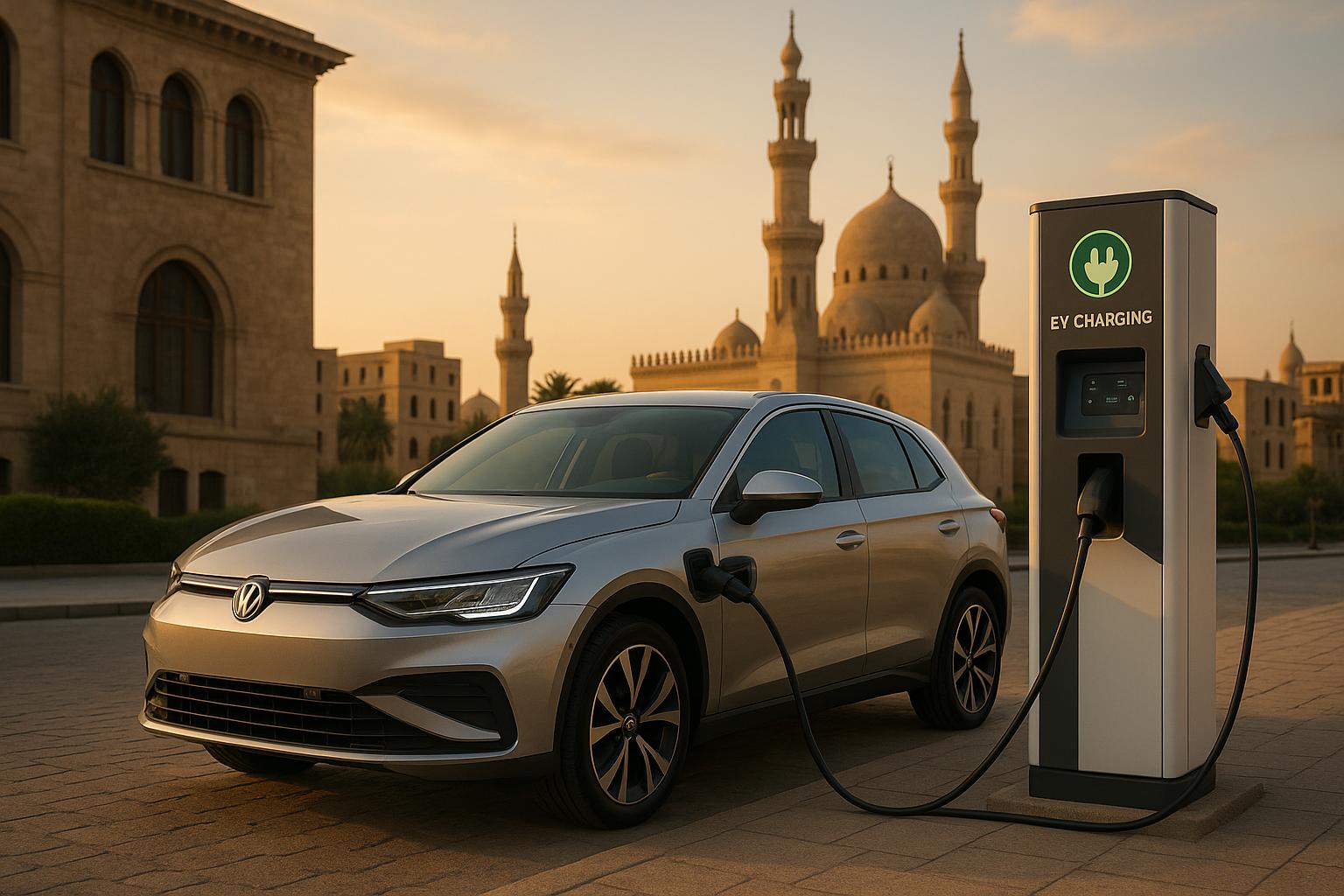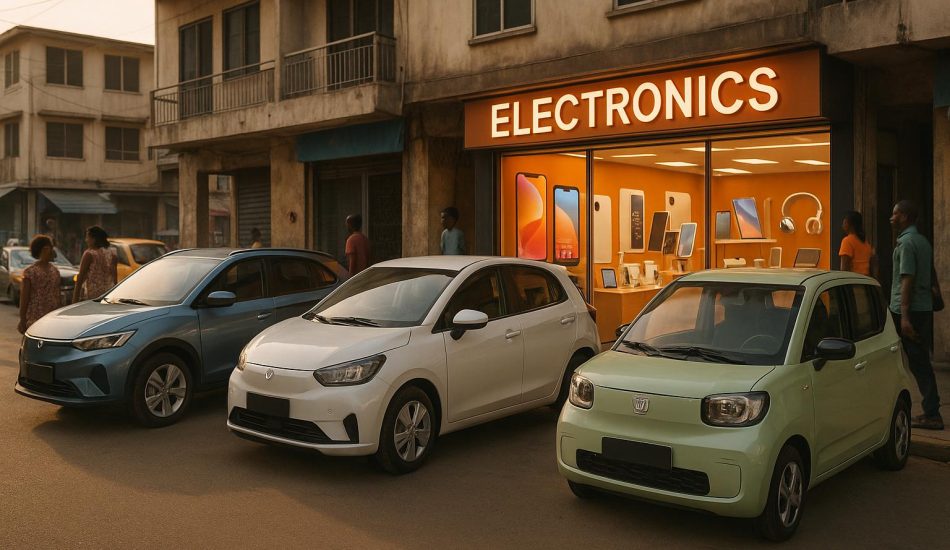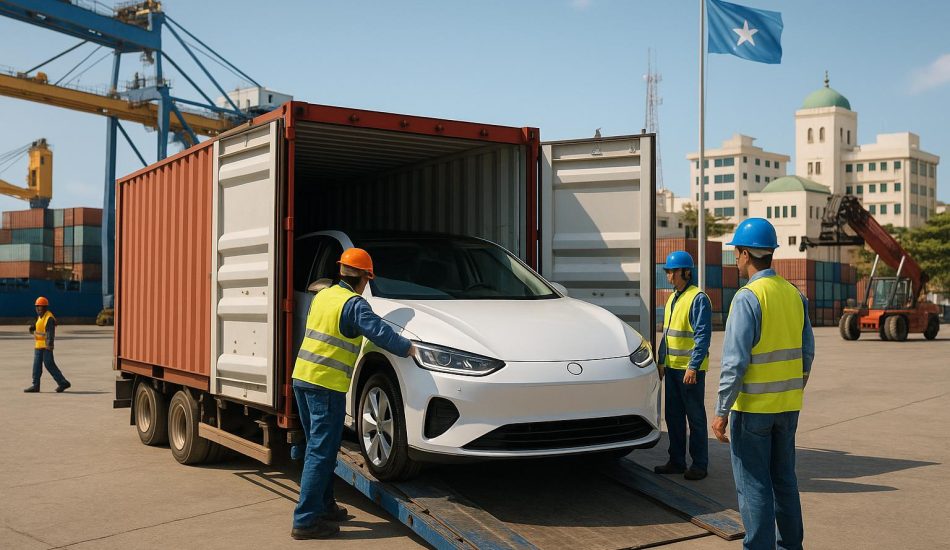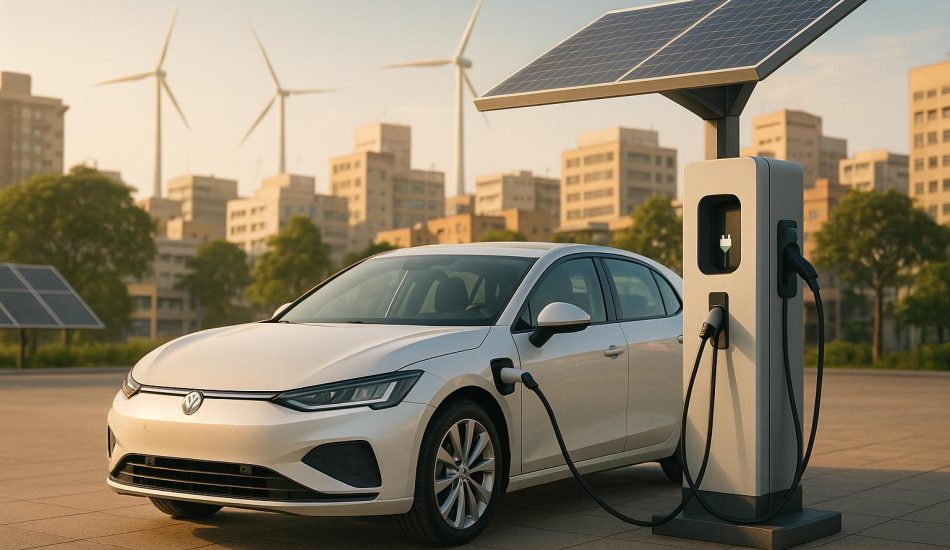
Thinking about buying an electric vehicle (EV) in Egypt? Here’s what you need to know:
- Government Incentives:
- Customs Exemption: EVs are exempt from customs duties under Ministerial Resolution 255/2018.
- Cash Subsidies: Up to EGP 50,000 ($993) for the first 100,000 locally produced EVs.
- Local Manufacturing Support: Tax breaks and subsidies for EVs with over 60% locally sourced components.
- Affordability Challenge:
- Most EVs cost over EGP 1 million ($19,915), far above the typical buyer’s budget of EGP 300,000–600,000 ($5,964–$11,925).
- Used EVs start at EGP 300,000 ($5,964), offering a more budget-friendly option.
- Charging Infrastructure:
- Current Network: Around 300 charging points nationwide, with plans to expand to over 3,000 by 2027.
- Key Players: Infinity leads with 700 charging points, aiming for 1,000 by end of 2025.
- Charging Costs: Home charging costs EGP 50–90 ($1.00–$1.79), while public fast chargers range from EGP 150–250 ($2.99–$4.98).
- Future Growth:
- By 2030, Egypt aims to produce 500,000 electric cars annually and expand charging infrastructure significantly.
- The EV market is expected to generate $20.08 billion in revenue by 2030.
Bottom Line: While EVs in Egypt face challenges like high upfront costs and limited infrastructure, government incentives and ongoing investments in local production and charging networks are making ownership more practical and affordable over time.
First electric car charging station opens ++REPLAY – FIRST AVAILABLE WEDNESDAY 21 FEBRUARY 2018++
Government EV Incentives in Egypt
The Egyptian government has introduced a series of financial incentives aimed at reducing the price gap between electric vehicles (EVs) and traditional cars, while also encouraging local manufacturing. These efforts are grouped into three main areas: tax and duty reductions, direct subsidies, and manufacturing incentives.
Tax and Import Duty Reductions
Under Ministerial Resolution 255/2018, EVs are fully exempt from customs duties, and used EVs (up to three years old) are allowed for import. Locally assembled EVs receive additional benefits, including VAT reductions alongside customs duty exemptions, making them more affordable. The government is also considering conditional customs exemptions for both new and used EV imports, which could further cut costs.
A 2% customs tariff applies to imported equipment for EV charging stations and conversion parts. Meanwhile, the government is evaluating additional incentives for EVs with over 60% locally sourced components, which could make domestically produced models even more attractive.
Direct Cash Subsidies for EV Buyers
To further bring down costs, the government offers direct cash subsidies for EV buyers. For the first 100,000 locally produced EVs, buyers can receive up to EGP 50,000 (around $993.14) per vehicle. To qualify for the full subsidy, the EV must have a range of at least 400 kilometers on a single charge. The Ministry of Public Enterprise has confirmed that this subsidy applies to buyers of locally manufactured electric cars.
This subsidy is particularly impactful when considering that most conventional cars in Egypt are priced between EGP 300,000 and 600,000 (approximately $5,964 to $11,925), while many EVs are priced above EGP 1 million (nearly $19,915). By bridging this price gap, the subsidy makes EVs a more accessible option for many buyers.
Local EV Manufacturing Support
In addition to tax breaks and subsidies, the government is actively supporting domestic EV production. In May 2025, the Cabinet approved a new automotive production incentive program as part of the National Automotive Industry Development Strategy. This program aims to increase local value-added components to 60% and ensure that over 35% of EVs manufactured in Egypt use locally sourced materials.
Manufacturers benefit from a range of incentives, including a flat 2% customs rate on imported equipment, a five-year exemption from stamp tax and registration fees, and grants of EGP 50,000 for the first 100,000 locally assembled EVs.
Currently, Egypt produces 45% of the components needed for EV manufacturing, positioning the country to scale up production. The government has set an ambitious goal of producing at least 500,000 electric cars annually by the end of the decade. For consumers, these manufacturing initiatives mean greater availability of EV models and potentially lower prices as production ramps up.
To further support this push, the Industrial Modernisation Centre has launched the National Programme for Encouraging Local Manufacturing, which includes a focus on EVs. Additionally, customs duty exemptions on imported components and raw materials are designed to help keep the prices of locally produced EVs competitive.
EV Charging Infrastructure in Egypt Today
Egypt’s electric vehicle (EV) charging network has grown over the past year, but it still struggles to keep pace with the rising demand for EVs. By late 2024, the country had around 300 functional charging points, which is a modest number considering the growing interest in EVs.
Public Charging Network Status
Currently, only five companies are licensed to operate charging stations in Egypt. Among them, Infinity is leading the charge, managing over 700 charging points across 16 governorates as of February 2025. The company aims to expand its network to 1,000 charging points by the end of 2025.
Although the demand for EV charging has doubled as Egypt transitions away from fossil fuels, the infrastructure is struggling to keep up. Ahmed Zein, Head of the Clean Energy Vehicles Committee at the Automotive Division, Chamber of Commerce, noted:
"But the infrastructure simply isn’t keeping up – especially when it comes to the distribution of charging stations".
Another challenge to network expansion is the low electricity rates set by the government, which make it harder for operators to scale.
Charger Types and Power Levels
Egypt’s EV charging infrastructure includes three main types of chargers, each designed for different charging needs:
| Charger Type | Power Output | Charging Time | Range Added Per Hour |
|---|---|---|---|
| Level 1 (AC Slow) | Up to 7.2 kW | Up to 12 hours for full charge | 6–8 kilometers (4–5 miles) |
| Level 2 (AC Fast) | 7.2–22 kW | 4–6 hours for full charge | 20–30 kilometers (12–19 miles) |
| Level 3 (DC Fast) | 22+ kW | 80% charge in 30 minutes | Varies by power level |
- Level 1 chargers are mainly used at home and rely on standard household outlets. While convenient for overnight charging, they only add about 6–8 kilometers (4–5 miles) of range per hour.
- Level 2 chargers, commonly found in public spaces, offer a balance between speed and cost. They can fully charge most EVs in 4–6 hours, adding around 20–30 kilometers (12–19 miles) of range per hour.
- DC Fast Chargers are the quickest, delivering an 80% charge in just 30 minutes. Infinity uses a mix of DC fast chargers, including Fast DC units (up to 50 kW) and Super Fast DC chargers (up to 90 kW). Other operators, like Sha7en, use advanced models such as the ABB TERRA 54 – a 50 kW DC fast charger compatible with CCS2 standards .
Most existing stations in Egypt provide a maximum output of 48 kWh, which results in longer charging times compared to European standards. While the performance of chargers is crucial, their placement is equally important for daily usability.
Where Charging Stations Are Located
Charging stations are mainly concentrated in Cairo and Alexandria, leaving Upper Egypt and rural areas with limited access . Companies like New Energy Egypt are working to expand the network by installing chargers at fuel stations (e.g., Chill Out and Wataniya), shopping centers (e.g., Cairo Festival City and City Stars), electric car dealerships, highways, and new urban developments like New Alamein and the New Administrative Capital.
Despite these efforts, highway coverage remains insufficient, making long-distance EV travel challenging. As Omar Salman, a car dealer, explained:
"But the biggest obstacle remains the lack of charging stations. Many roads and governorates still have no access to EV chargers, which limits widespread adoption. Still, we’re seeing a strong push to grow the market".
For daily use, EV owners are encouraged to download mobile apps to locate nearby charging stations and check real-time availability. However, planning is crucial for trips outside Cairo and Alexandria, where charging options are scarce.
To address these gaps, the government has announced plans to install over 3,000 public chargers by 2027. Until then, the current network of around 300 charging points serves a growing EV population, which now includes 8,500 licensed EVs out of more than 5 million private vehicles in Egypt.
Financial Analysis for EV Buyers
When considering buying an electric vehicle (EV) in Egypt, it’s essential to look beyond the upfront price tag. The long-term savings from reduced fuel costs, minimal maintenance expenses, and government incentives can make EV ownership a smart financial decision. While the initial investment can be steep, the operational savings over time often outweigh the higher purchase price.
Purchase Price vs. Operating Savings
One of the biggest hurdles for Egyptian EV buyers is the initial cost. As Mohamed Badawi, CEO of Revolta Egypt, points out:
"The cheapest brand new electric car costs around EGP 750,000 ($14,925). This price is not affordable for everyone in Egypt."
Currently, new EVs in Egypt are priced between EGP 1-1.5 million ($19,915-$29,873), while used EVs provide a more accessible option starting at around EGP 300,000 ($5,964).
However, the real savings come from operating an EV. According to Dr. Mohamed Hlep:
"The operational costs of electric vehicles represent only 15% to 20% compared to gasoline."
For context, filling up a gasoline car costs about EGP 225 ($4.48), while fully charging an EV at home costs just EGP 50-90 ($1.00-$1.79). Even using public DC fast chargers is less expensive, ranging from EGP 150-250 ($2.99-$4.98). Maintenance costs are also much lower. With only one moving part in an electric motor – compared to the many components in a traditional engine – EV owners avoid expenses like oil changes and frequent brake replacements.
By combining these operational savings with government incentives, EV buyers can significantly reduce their overall expenses.
How to Combine Multiple Incentives
Egypt offers several incentives that can make EV ownership more affordable, especially when used strategically. For instance, subsidies for locally produced electric cars can offset a portion of the upfront cost, as detailed in the government subsidy section.
Tax benefits are another way to save. Projects focused on electrification and local car assembly can deduct 30% of the initial investment cost from taxable net profit, with this deduction increasing to 50% for buyers in specific development zones.
Import-related incentives also play a role. The government provides a 2% flat customs rate on EV-related equipment and offers a five-year exemption from stamp tax and registration fees. Companies that introduce new EV technologies or commit to full local assembly within five years may also benefit from expedited customs clearance and additional support.
Dealers often contribute to affordability by offering financing plans, extended warranties, or charging equipment bundles. To maximize these benefits, buyers should:
- Research which EV models qualify for local assembly subsidies.
- Confirm eligibility for relevant tax write-offs.
- Discuss manufacturer incentives and dealer-specific offers.
It’s worth noting that Egypt’s incentive programs are evolving. Authorities are exploring additional benefits for EVs with local component ratios above 60%, potentially leading to even greater savings for future buyers. Staying informed about these changes can help buyers make the most of their investment.
sbb-itb-99e19e3
Daily EV Ownership in Egypt
Owning an EV in Egypt comes with its own set of challenges and considerations, especially when it comes to charging and planning trips. With around 300 functional charging points nationwide supporting over 7,000 EVs, navigating daily life as an EV owner requires thoughtful preparation for both charging and travel.
Charging Costs and Payment Options
Charging an EV in Egypt is relatively affordable compared to traditional fuel costs. Charging at home using AC chargers typically costs between EGP 50–90 ($1.00–$1.79) per full charge, depending on battery capacity. For faster charging, DC chargers are available at public stations, costing EGP 150–250 ($2.99–$4.98) per session. In contrast, gasoline prices have risen, with 80 octane priced at EGP 13.75 ($0.28) per liter and 95 octane at EGP 17 ($0.35) per liter, as of October 2024.
As for payments, public charging stations have embraced digital solutions. Networks like Sha7en allow users to pay through mobile wallets linked to debit or credit cards. The process is straightforward: download the network’s app, set up an account, and load funds. This cashless approach is similar to platforms like the JTNY ride-hailing app, which also relies on digital payments.
These details on costs and payment options are essential for planning both daily commutes and longer journeys with an EV.
Planning for Long-Distance Travel
When it comes to long-distance trips, EV owners need to think ahead. The limited charging infrastructure means careful route planning is a must, along with allowing extra time for charging stops. Charging times can also be longer due to technical limitations, making home charging setups a practical option for starting trips with a fully charged battery.
Mobile apps can help locate charging stations, though availability varies across different regions. Infrastructure is improving gradually, thanks to public–private partnerships working to install more AC and DC chargers at busy gas stations. Companies like ADNOC Distribution are exploring opportunities in Egypt’s EV market, with plans to expand charging networks that could make intercity travel more convenient.
For now, EV owners traveling between cities need to plan routes with backup charging options and factor in extra time for stops. While trips within urban hubs like Cairo and Alexandria are relatively easy to manage, intercity travel demands more preparation and flexibility.
Egypt’s EV Market in 2030
The current EV market in Egypt faces hurdles like limited infrastructure and steep upfront costs, but the vision for 2030 aims to change that narrative. As part of Egypt’s Vision 2030, the country plans to completely phase out petrol and diesel vehicles by 2040. This ambitious goal is backed by significant investments in infrastructure and local production to create a thriving EV ecosystem.
By 2030, the EV market in Egypt is projected to generate around $20.08 billion in revenue, with an annual growth rate of 12.03%. This marks a massive leap from the expected $5.3 million in revenue in 2025. Below, we explore how the country is gearing up for this transformation through infrastructure development and local manufacturing.
2030 Charging Network Expansion Plans
Addressing the current gaps in charging infrastructure, Egypt’s 2030 plan includes a major push to expand access to charging stations. The government has allocated at least EGP 450 million ($8.95 million) to build a comprehensive network of charging points across the country.
Infinity, a key player in this effort, is set to install 6,000 charging points at 3,000 stations nationwide. These efforts are being driven through strong public-private partnerships. Hassan Allam Utilities is a major contributor to this initiative. As CEO Dalia Wahba explains:
"This partnership reflects our commitment to investing in sustainable infrastructure that supports Egypt’s energy transition. By joining forces with industry leaders, we are taking a major step toward building an integrated EV ecosystem that facilitates the shift to sustainable and eco-friendly transportation".
With more than 7,000 EVs already on Egypt’s roads, expanding the charging network is essential to support the growing number of electric vehicles.
Local EV Manufacturing Growth
Making electric vehicles more affordable is a key focus of Egypt’s EV strategy, and the government is banking on local manufacturing to achieve this. By 2030, the goal is to produce at least 500,000 electric cars annually, with 45% of the required components already being manufactured domestically.
Several partnerships are fueling this manufacturing drive. In May 2024, GV Investments teamed up with China’s FAW Group to produce low-cost EVs locally, with production of FAW’s most affordable model set to start in early 2025. Similarly, BAIC and Alkan Auto, a subsidiary of the Egyptian International Motors Group, are preparing to launch their factory by the end of 2025. Their initial target is to produce 20,000 cars in the first year, scaling up to 50,000 units annually within five years.
The government is also incentivizing local production through subsidy programs and plans to increase the local content of EVs to between 60% and 80% by 2030. Projects achieving over 50% local content will benefit from perks like favorable customs policies, subsidies for operating costs, workforce training, and tax breaks.
Supporting industries are expanding alongside vehicle production to build a complete EV ecosystem. For instance, Sumitomo Electric Industries has opened a factory in 10th of Ramadan City to manufacture electric braids, creating 3,500 jobs. Similarly, Yazaki has established a facility in Fayoum to produce automotive components for export.
As automotive expert Gamal Askar highlights:
"The Egyptian government has also been proactive in encouraging foreign investment in the EV sector. New legislation offers tax breaks and incentives for companies manufacturing or assembling electric cars in Egypt, while infrastructure projects are underway to build charging stations across major cities".
This push for local manufacturing is also aimed at addressing the affordability challenge. Currently, many EVs in Egypt are priced above EGP 1 million ($19,915), while most car buyers in the country are looking for vehicles in the EGP 300,000 ($5,964) to EGP 600,000 ($11,925) range. By ramping up local production, the government hopes to bring down prices, making EVs more accessible to a broader audience.
Key Points for EV Buyers in Egypt
Navigating Egypt’s growing EV market requires understanding how government incentives and charging infrastructure impact your purchase. Here are some key considerations for making an informed decision.
Government incentives make EVs more affordable. Policies like customs exemptions and subsidies for locally produced vehicles significantly reduce the cost of owning an EV. These incentives are designed to encourage adoption and ease the financial burden for buyers.
High upfront costs are offset by savings over time. While EVs may have a higher initial price tag, combining government incentives with lower operational costs – like cheaper charging compared to traditional fuel – can make them a smart long-term investment.
Charging infrastructure is improving but requires planning. As of late 2024, Egypt has around 300 operational charging points and over 7,000 EVs on the road. While home charging and public fast-charging stations offer considerable savings, limited access in certain areas means buyers need to plan ahead.
Location matters for EV ownership. Charging station availability varies widely. According to Ahmed Zein from the Chamber of Commerce, "charging station distribution isn’t keeping pace with growing demand". Car dealer Omar Salman adds, "Many roads and governorates still have no access to EV chargers, which limits widespread adoption. Still, we’re seeing a strong push to grow the market". Urban centers like Cairo and Alexandria offer better infrastructure compared to rural areas, making location a critical factor in your decision.
Act early to maximize benefits. With the EV market expected to generate $20.08 billion in revenue by 2030 and local assembly subsidies capped at 100,000 vehicles, early adopters stand to gain the most. Additionally, the government plans to install over 3,000 public EV chargers by 2027, signaling continued improvements.
Stay informed about policy changes. Current incentives include a 2% flat customs rate on imported EV equipment and five-year exemptions from stamp tax and registration fees. However, these policies may evolve as the market matures, so keeping up-to-date is essential.
FAQs
What government incentives are available for electric vehicle buyers in Egypt, and how can they benefit from them?
Government Incentives for EV Adoption in Egypt
Egypt has rolled out a series of government incentives to make electric vehicle (EV) ownership more appealing and affordable:
- Subsidies: Buyers of locally manufactured EVs can receive financial support of up to EGP 50,000 (approximately $1,000).
- Tax Benefits: EVs and their components qualify for exemptions on certain taxes as well as reduced customs duties.
- Customs Discounts: Imported EV-related equipment benefits from a flat 2% customs rate and a five-year exemption from stamp taxes.
To access these incentives, buyers usually go through authorized dealerships or programs backed by the government. These initiatives aim to lower the financial barriers to EV ownership, paving the way for Egypt’s transition to cleaner and more sustainable transportation options.
How does Egypt’s charging infrastructure impact the practicality of owning an electric vehicle?
The feasibility of owning an electric vehicle (EV) in Egypt hinges significantly on the country’s charging infrastructure. At present, there are approximately 300 charging stations nationwide – a number that falls short given the growing interest in EVs. Recognizing this, the government is actively working to expand the network, aiming to make EV ownership more accessible and convenient.
Beyond infrastructure, Egypt has introduced incentives to encourage EV adoption. For instance, subsidies are available for the first 100,000 EVs produced locally, offering savings of up to $1,600 per vehicle. While these measures help reduce costs and promote EV adoption, the limited availability of charging stations remains a major hurdle. Expanding this infrastructure is critical to supporting the shift toward electric mobility in the country.
What are the financial advantages of owning an electric vehicle in Egypt compared to a gasoline car?
Owning an electric vehicle (EV) in Egypt can lead to substantial savings over time compared to a gasoline-powered car. For starters, charging an EV costs about one-third of what you’d spend on gasoline, making everyday driving much more affordable. On top of that, EVs are built with fewer moving parts, which translates to lower maintenance and repair expenses in the long run.
To sweeten the deal, the Egyptian government provides tax breaks and subsidies to help offset the initial cost of purchasing an EV. When you combine these incentives with the reduced operating expenses, switching to an EV becomes a financially savvy choice for anyone ready to move away from traditional gasoline vehicles.




